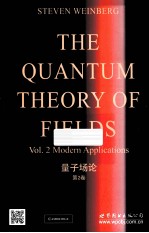

量子场论 第2卷 英文PDF电子书下载
- 电子书积分:15 积分如何计算积分?
- 作 者:(美)温伯格(StevenWeinberg)著
- 出 版 社:世界图书出版公司北京公司
- 出版年份:2014
- ISBN:9787510075889
- 页数:489 页
15 NON-ABELIAN GAUGE THEORIES 1
15.1 Gauge Invariance 2
15.2 Gauge Theory Lagrangians and Simple Lie Groups 7
15.3 Field Equations and Conservation Laws 12
15.4 Quantization 14
15.5 The De Witt-Faddeev-Popov Method 19
15.6 Ghosts 24
15.7 BRST Symmetry 27
15.8 Generalizations of BRST Symmetry 36
15.9 The Batalin-Vilkovisky Formalism 42
Appendix A A Theorem Regarding Lie Algebras 50
Appendix B The Cartan Catalog 54
Problems 58
References 59
16 EXTERNAL FIELD METHODS 63
16.1 The Quantum Effective Action 63
16.2 Calculation of the Effective Potential 68
16.3 Energy Interpretation 72
16.4 Symmetries of the Effective Action 75
Problems 78
References 78
17 RENORMALIZATION OF GAUGE THEORIES 80
17.1 The Zinn-Justin Equation 80
17.2 Renormalization:Direct Analysis 82
17.3 Renormalization:General Gauge Theories 91
17.4 Background Field Gauge 95
17.5 A One-Loop Calculation in Background Field Gauge 100
Problems 109
References 110
18 RENORMALIZATION GROUP METHODS 111
18.1 Where do the Large Logarithms Come From? 112
18.2 The Sliding Scale 119
18.3 Varieties of Asymptotic Behavior 130
18.4 Multiple Couplings and Mass Effects 139
18.5 Critical Phenomena 145
18.6 Minimal Subtraction 148
18.7 Quantum Chromodynamics 152
18.8 Improved Perturbation Theory 157
Problems 158
References 159
19 SPONTANEOUSLY BROKEN GLOBAL SYMMETRIES 163
19.1 Degenerate Vacua 163
19.2 Coldstone Bosons 167
19.3 Spontaneously Broken Approximate Symmetries 177
19.4 Pions as Goldstone Bosons 182
19.5 Effective Field Theories:Pions and Nucleons 192
19.6 Effective Field Theories:General Broken Symmetries 211
19.7 Effective Field Theories:SU(3)×SU(3) 225
19.8 Anomalous Terms in Effective Field Theories 234
19.9 Unbroken Symmetries 238
19.10 The U(1) Problem 243
Problems 246
References 247
20 OPERATOR PRODUCT EXPANSIONS 252
20.1 The Expansion:Description and Derivation 253
20.2 Momentum Flow 255
20.3 Renormalization Group Equations for Coefficient Functions 263
20.4 Symmetry Properties of Coefficient Functions 265
20.5 Spectral Function Sum Rules 266
20.6 Deep Inelastic Scattering 272
20.7 Renormalons 283
Appendix Momentum Flow:The General Case 288
Problems 292
References 293
21 SPONTANEOUSLY BROKEN GAUGE SYMMETRIES 295
21.1 Unitarity Gauge 295
21.2 Renormalizable ξ-Gauges 300
21.3 The Electroweak Theory 305
21.4 Dynamically Broken Local Symmetries 318
21.5 Electroweak-Strong Unification 327
21.6 Superconductivity 332
Appendix General Unitarity Gauge 352
Problems 353
References 354
22 ANOMALIES 359
22.1 Theπ° Decay Problem 359
22.2 Transformation of the Measure:The Abelian Anomaly 362
22.3 Direct Calculation of Anomalies:The General Case 370
22.4 Anomaly-Free Gauge Theories 383
22.5 Massless Bound States 389
22.6 Consistency Conditions 396
22.7 Anomalies and Goldstone Bosons 408
Problems 416
References 417
23 EXTENDED FIELD CONFIGURATIONS 421
23.1 The Uses of Topology 422
23.2 Homotopy Groups 430
23.3 Monopoles 436
23.4 The Cartan-Maurer Integral Invariant 445
23.5 Instantons 450
23.6 The Theta Angle 455
23.7 Quantum Fluctuations around Extended Field Configurations 462
23.8 Vacuum Decay 464
Appendix A Euclidean Path Integrals 468
Appendix B A List of Homotopy Groups 472
Problems 473
References 474
AUTHOR INDEX 478
SUBJECT INDEX 484
- 《量子系统的非平衡多体理论》(意)G.斯蒂芬尼茨,(德)R.冯·莱文 2019
- 《量子力学基础》郑伟谋著 2019
- 《量子规范场论的解释 理论、实验、数据分析》(中国)李继堂 2019
- 《高等量子力学》闫学群 2019
- 《量子计算数论=QUANTUM COMPUTATIONAL NUMBER THEORY》(英)颜松远著 2020
- 《实现你的愿景 创客量子能力7大法则》(美)克里斯蒂·惠特曼(CHRISTY WHITMAN)著 2020
- 《量子有限自动机 等价性和最小化》李绿周 2019
- 《量子力学=Quantum Mechanics(Jones & Bartlett):英文》(美)B.C.里德(Bruce Cameron Reed)著 2018
- 《鬼脸物理课 4 量子论与未来》刘继军著 2019
- 《佛法人生量子说》高月明著 2016
- 《TED说话的力量 世界优秀演讲者的口才秘诀》(坦桑)阿卡什·P.卡里亚著 2019
- 《小手画出大世界 恐龙世界》登亚编绘 2008
- 《近代世界史文献丛编 19》王强主编 2017
- 《课堂上听不到的历史传奇 世界政治军事名人 初中版》顾跃忠等编著 2015
- 《指向核心素养 北京十一学校名师教学设计 英语 七年级 上 配人教版》周志英总主编 2019
- 《365奇趣英语乐园 世界民间故事》爱思得图书国际企业 2018
- 《近代世界史文献丛编 36》王强主编 2017
- 《北京生态环境保护》《北京环境保护丛书》编委会编著 2018
- 《近代世界史文献丛编 11》王强主编 2017
- 《近代世界史文献丛编 18》王强主编 2017
